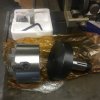KeithB
Resident Half Fast Machinist
Been using a lot of 5C collets lately, I now have collet chucks for both lathes, a collet chuck on an angle plate for stationary use, and a collet chuck on my rotary table. Very handy for handling stuff up to 1-1/8" diameter but nothing bigger. Sometimes it seems like it might be handy to have a a chuck for handling slightly larger pieces w/o having to replace the collet chuck with a regular 8"-10" chuck.
The photo below shows the solution. I got the 4" four-jaw chuck and fixture mount type collet from Shars, it was a little over $150 total, $100 for the chuck and $50 or so for the fixture mount collet. Shars sells this combo already set up for about the same price but they were out of stock so I opted to get the components and do it myself. I have to put the collet in the lathe chuck and machine the face and a turn to align inside a bore in the back of the chuck. Then I will put it on the mill and drill and counterbore the four holes for the screws that go into the back of the chuck. The dimensions are all pretty well documented in the literature that came with it and they all seem to be right on.
I don't plan on spinning this thing at high speed, mostly I think it will be used on the rotary table on the mill.


The photo below shows the solution. I got the 4" four-jaw chuck and fixture mount type collet from Shars, it was a little over $150 total, $100 for the chuck and $50 or so for the fixture mount collet. Shars sells this combo already set up for about the same price but they were out of stock so I opted to get the components and do it myself. I have to put the collet in the lathe chuck and machine the face and a turn to align inside a bore in the back of the chuck. Then I will put it on the mill and drill and counterbore the four holes for the screws that go into the back of the chuck. The dimensions are all pretty well documented in the literature that came with it and they all seem to be right on.
I don't plan on spinning this thing at high speed, mostly I think it will be used on the rotary table on the mill.









